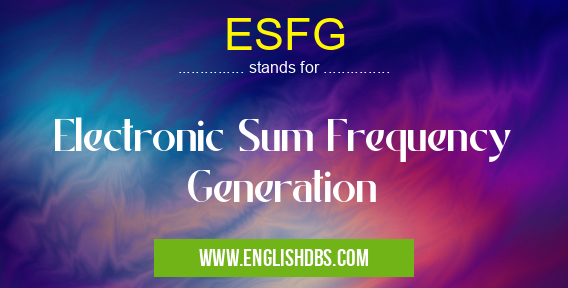What does ESFG mean in ELECTRONICS
ESFG (Electronic Sum Frequency Generation) is a versatile nonlinear optical technique widely used in surface and interface science. It combines two laser beams with different frequencies to generate a third beam with a frequency equal to the sum of the original frequencies. ESFG is a powerful tool for probing molecular orientation, vibrational dynamics, and surface structure at the interface between two media.

ESFG meaning in Electronics in Academic & Science
ESFG mostly used in an acronym Electronics in Category Academic & Science that means Electronic Sum Frequency Generation
Shorthand: ESFG,
Full Form: Electronic Sum Frequency Generation
For more information of "Electronic Sum Frequency Generation", see the section below.
Principle of Operation
In ESFG, a high-energy (visible or UV) beam and a lower-energy (infrared or THz) beam are overlapped at the interface of interest. The nonlinear interaction between the two beams generates a third beam, known as the ESFG signal. The frequency of the ESFG signal is the sum of the frequencies of the input beams.
Applications
ESFG has numerous applications in surface science, including:
- Probing molecular orientation and dynamics at liquid-vapor, solid-liquid, and solid-gas interfaces
- Investigating vibrational properties of surface-adsorbed species
- Characterizing surface structure and morphology
- Studying biological processes at interfaces
Advantages
- Surface Specificity: ESFG is sensitive to the interface region, providing information about the molecular structure and dynamics at the surface without interference from bulk contributions.
- Vibrational Sensitivity: ESFG detects vibrational modes of molecules, allowing for the identification and characterization of specific chemical species at the interface.
- Non-Destructive: ESFG is a non-invasive technique that does not damage or alter the surface under investigation.
- Sub-Micron Spatial Resolution: ESFG can probe interfaces with sub-micron spatial resolution, enabling the study of small features and patterns.
Essential Questions and Answers on Electronic Sum Frequency Generation in "SCIENCE»ELECTRONICS"
What is Electronic Sum Frequency Generation (ESFG)?
Electronic Sum Frequency Generation (ESFG) is a nonlinear optical technique that involves the interaction of three laser beams to generate a fourth beam at a new frequency. The sum frequency of the generated beam is equal to the sum of the frequencies of the three incident beams. ESFG is a powerful tool for studying the electronic structure and dynamics of materials.
What are the applications of ESFG?
ESFG has a wide range of applications in surface science, electrochemistry, and materials science. It can be used to study the orientation and ordering of molecules on surfaces, the dynamics of interfacial charge transfer, and the electronic structure of semiconductors. ESFG is also a valuable tool for characterizing the properties of thin films and nanomaterials.
How does ESFG work?
ESFG occurs when three laser beams interact in a nonlinear material. The first beam (the pump beam) excites electrons in the material to a higher energy level. The second beam (the signal beam) then interacts with the excited electrons, causing them to emit photons at a frequency that is the sum of the frequencies of the pump and signal beams. The third beam (the idler beam) is generated as a result of the energy conservation law.
What are the advantages of ESFG?
ESFG has several advantages over other nonlinear optical techniques. It is a surface-specific technique, which means that it can be used to study the properties of surfaces without being affected by the bulk material. ESFG is also a non-destructive technique, which makes it ideal for studying delicate samples. Additionally, ESFG can be used to study a wide range of materials, including metals, semiconductors, and insulators.
What are the limitations of ESFG?
ESFG is a relatively weak signal, which can make it difficult to measure. Additionally, ESFG can only be used to study the properties of surfaces that are optically accessible.
Final Words: ESFG is a powerful surface analytical technique that provides detailed information about the molecular structure, dynamics, and morphology of interfaces. Its non-destructive nature and sub-micron spatial resolution make it an invaluable tool for a wide range of applications in surface science, biophysics, and materials science.
